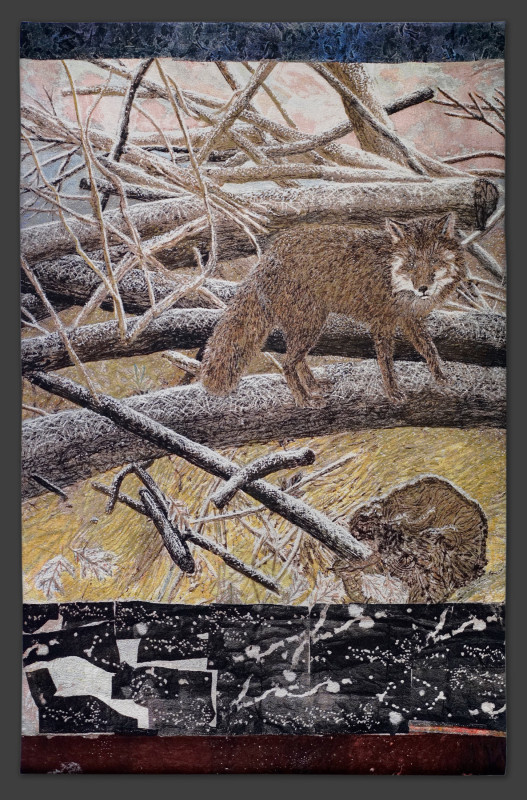
Jacquard tapestry
116 x 76 in
edition of 10
As an artist whose practice revels in the possibilities of printmaking and multiples, it seems only natural that Kiki Smith has been working with Magnolia Editions since 2011 on a suite of editioned Jacquard tapestries.
Smith’s collaged layouts for her suite of tapestries incorporate an endless variety of techniques and media, with glitter, colored pencil, watercolor and a host of printed materials traversing multiple pieces of cut Nepalese paper in a landscape of heterogenous textures. The final weaving of each mixed-media amalgam into a single textile object contributes to the sense of underlying spiritual connection among the tapestries’ diverse population of flora and fauna. Smith’s editions are united further by the series of horizontal bands that pass through each tapestry, as if to suggest that within each ‘realm’ there exists the same strata of sky, land, and underground.
Each of Smith’s tapestry editions has undergone dozens of steps and versions on its way to completion, in some cases taking several years to reach its final incarnation. Smith typically begins by sending a large-scale collage on paper to Magnolia’s Oakland studio, often accompanied by various smaller etchings and drawings. These constituent elements are scanned and photographed at high resolution and then combined and manipulated digitally by the artist with Magnolia director Donald Farnsworth and Magnolia master printer Nicholas Price’s assistance. After each digital revision, Smith has Magnolia print large-scale proofs on paper so that she can continue to work directly on their surfaces with watercolors, ink, and other media. “This way,” Farnsworth points out, “the artist’s reaction is physical, in her studio; she’s not just reacting to a computer screen.”
As Smith travels frequently for shows and events around the world, she and Price often teleconference to digitally collage and edit the various layers, manipulating the same file in Adobe Photoshop together in real time across thousands of miles. “She’s also very invested in printmaking in a way that’s unique,” says Price, “because often the prints become other things. For example, the deer in Fortune was a big etching which she had collaged on to the original layout. It was a bit unfinished: the eyes were empty — so she’s putting down a groundwork, using it as a jumping-off point to do other things.”
In this ongoing series of thematically linked, dreamlike visions of the natural world, Smith continues to raise the art of collage to new heights. Magnolia’s tapestry technique has proved to be an ideal vehicle for Smith’s practice, yielding objects halfway between printmaking and sculpture, rooted in the Medieval yet informed by digital sophistication, and possessing a complex yet beguilingly tactile surface.
– Nick Stone, February 2015
show prices
Prices and availability are subject to change without notice.The copyright of all art images belongs to the individual artists and Magnolia Editions, Inc.
©2003-2024 Magnolia Editions, Inc. All rights reserved. contact us
